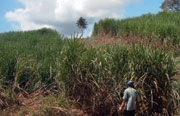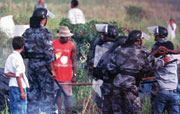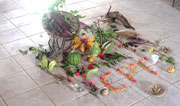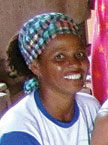Earth, water, seeds, life
By Kathy Gillis
January/February 2011
Return to Table of Contents
Print Article
Mile after mile, nothing but sugarcane fields fill the windows of our van. This area was once lush forest. Today less than three percent of the Atlantic forest remains from when this coastal region of Brazil was colonized in the 1500s. The small remaining islands of forest, called the Atlantic Forest Zone, is preserved amidst a “green desert” of sugarcane.
Here, more than 90 percent of the cane is cut by hand. One “cold meal” worker can cut five to six tons of cane a day and earn 10 Reais a ton (a little less than CDN$6). These seasonal workers come here from other parts of the Northeast to earn money to support their wife and children back home. The cut cane is taken to the mills in trucks and separated for either ethanol or sugar production, depending on market supply and demand.
About 70 percent of the people of this area are directly connected to the sugarcane industry. With the monoculture of sugarcane, plantation owners have evicted many families and communities so as to obtain more land to grow even more cane. The people want land to grow food crops for their own consumption and to sell in nearby villages.
We are on our way to meet members of three of these communities who have obtained legal entitlement to land after years of struggle. Accompanied by a representative from the Brazilian Bishops’ Pastoral Land Commission (CPT), we arrive at the Chico Mendes community centre named after the well-known leader of the movement to save the Amazon rainforest. Chico Mendes was martyred in 1988.
The poster on the wall of the Centre reads, “What future do you prefer, biodiversity or a green desert?” Members of the community association welcome us and tell us that our visit is “an exchange of experience.” Laid out in a circle on the floor are items representing the people’s life and livelihood, including seeds, water, earth, the foods that they grow—all surrounded by pictures of their struggle for land. The letters “CPT” are written in corn and beans.
“Earth, water, seeds, life!” the young man says as he moves around the room with a small branch and a bowl of water, lightly sprinkling everyone in blessing. A young woman reads Psalm 61: “...For you have been my refuge, a strong tower against the foe...” We are participating in a mística, a characteristic of the Landless Movement in which the people articulate their struggles and reality, their empowerment, love, and solidarity through a celebration of the Word of God.
The community association represents three settlements of 160 families, all concentrated in one area with the land belonging to all. Each family has its own house with six to eight hectares for growing a variety of crops. The people have been in this region for generations and many had worked in the cane fields. In March 1997, after they were evicted from their homes by the plantation owners, they decided to come together to fight for their right to land. The CPT have accompanied these communities since they started preparing their action.
Louisa (inset) begins to tell us their story. There were many moments of adversity and resistance since the action began. After eviction, the people set up a roadside camp, going to the fields each day so that they could continue to plant and tend their crops. They numbered nearly 200 with two or three families in each tent. At night their sleep was disturbed with the vibration of the cars and plantation trucks going past. Sometimes they awoke to gunshots fired by militia hired by the sugar mills to frighten them. These armed thugs, carrying machine guns, chased the people. The police came too, supported by the sugar barons and staying at their big estates.
“Everything we had done to achieve economic sustainability, they came to destroy with the support of the state,” Louisa says. Men, women, and children were beaten, their crops destroyed, the river water poisoned, and sand put in the wells. The people no longer had access to the river to wash their clothes.
Through it all they continued the resistance. “One thing they could not destroy,” she says, “was our dignity.”
They went to Brasilía, the capital, to fight through legal means with a lawyer from the CPT. They also had support from areas of civil society and from the international community with people coming from other countries to stand with them in solidarity. Many priests supported them. At this point in Louisa’s story, others in the room call out the names of priests. Dom Pedro Casaldáliga and other bishops came, she says. “It was important to have the priests and bishops with us as this reconfirmed the faith of every man, woman, and child in the community.”
It was a long legal battle with seemingly hopeless moments, but their lawyer told them, “If you can see a light at the end of the tunnel, I will continue to fight for you.”



 Photos: After eviction by the sugar plantation owners, the people were intimated and abused in their struggle for land, but they were victorious. Without land, they would have been forced to the cities where there is no work, and to live in dangerous slums. Today, the three communities live in one area, sharing the land in common, with each family in their own home and able to support themselves.
Photos: After eviction by the sugar plantation owners, the people were intimated and abused in their struggle for land, but they were victorious. Without land, they would have been forced to the cities where there is no work, and to live in dangerous slums. Today, the three communities live in one area, sharing the land in common, with each family in their own home and able to support themselves.
Today, Louisa’s daughter and many others still suffer from psychological and health problems from the trauma of the experience and from ingesting the poisoned water and food.
Others in the room share their memories of the intimidation and struggle, speaking in turn. And then Louisa says, “We have been talking about the bad parts.” She wants to close on a memory of hope and tells us about an action by the women on May 1, 2003. In the face of the destruction of their crops and with the men threatened with beatings if they went back to their fields, the women decided that they would replant the crops collectively, doing all the field and planting work. Soon the police and the aggressors arrived and told the women that they had 10 minutes to leave.
“We resisted the whole day,” Louisa says. “More and more women arrived, and then the men and children, and the CPT came with other groups by the busload. The police came on horses and with dogs, but they could not stop the action.” The people were victorious.
At the end of our visit and after sharing in a meal from the bounty of their land, I am given the task of thanking the people. My voice breaks from the impact of their courage and strength in the face of real persecution, struggling for a piece of land to live on that would provide for their needs. I promise them that we will not forget them and will tell others about them. This is their story.
Return to Table of Contents
Print Article

